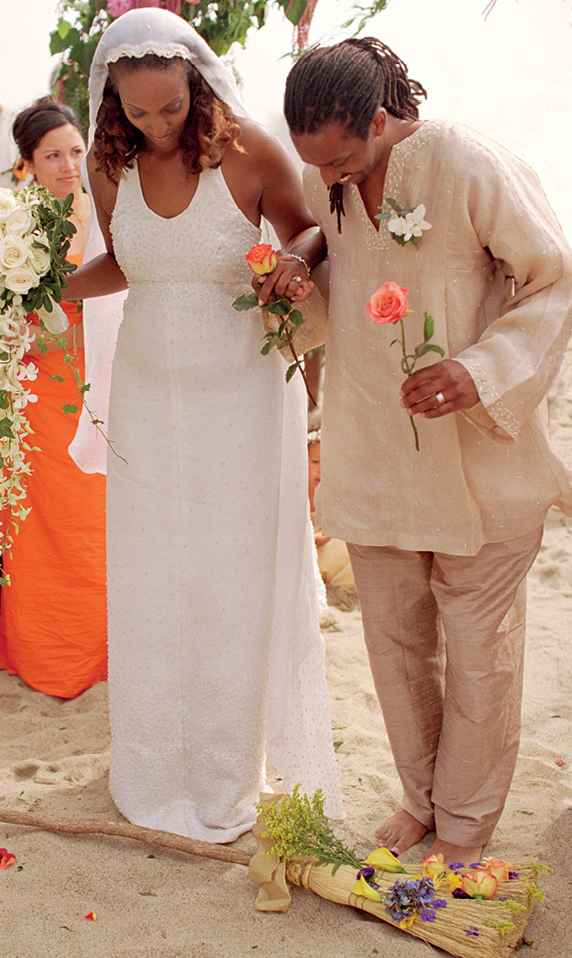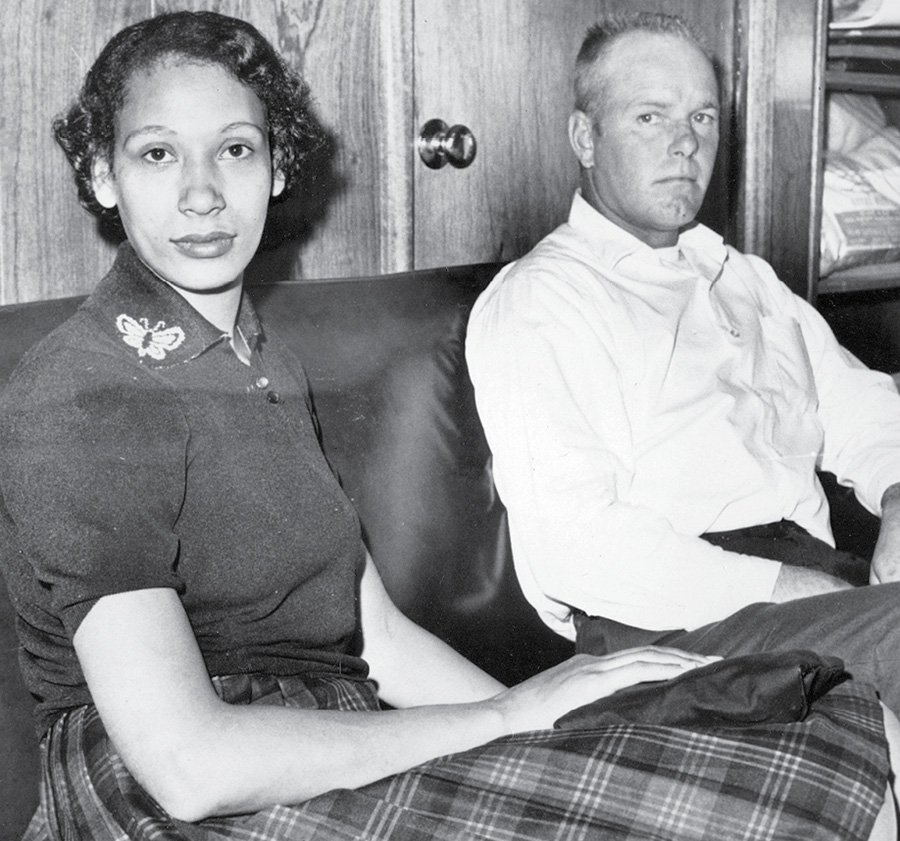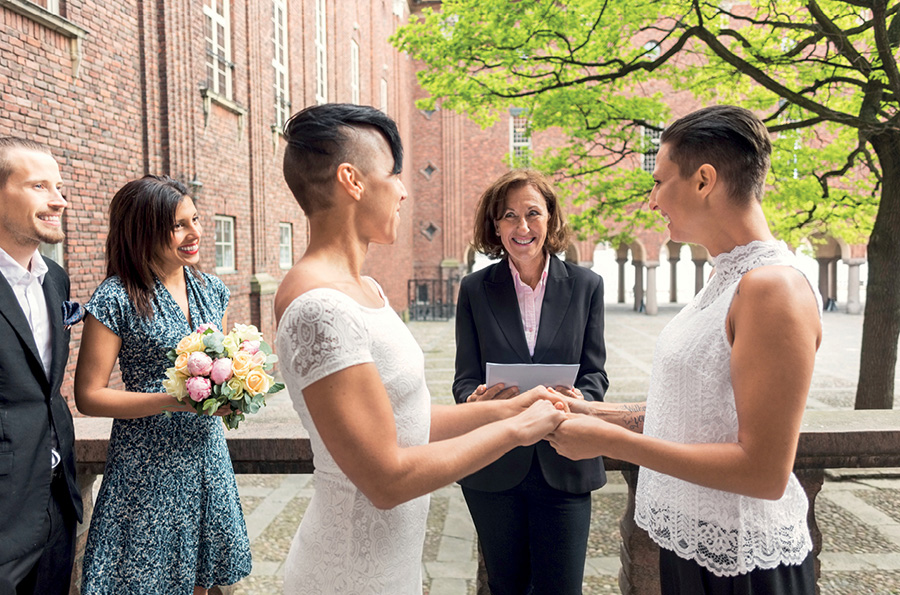3
Forbidden Love
Not long ago, none of these couples would have been allowed to marry:
Ashton Kutcher and Mila Kunis
David Bowie and Iman
Kanye West and Kim Kardashian
Taye Diggs and Idina Menzel
Neil Patrick Harris and David Burtka
Ellen DeGeneres and Portia de Rossi
Keeping the Faith
In Europe during the Middle Ages, Christians were forbidden to share meals with Jews much less marry them. The actors Ashton Kutcher, who is Catholic, and Mila Kunis, who is Jewish, would have been out of luck had they lived then.
The Quran has rules about interfaith marriages. It says that Muslim men can marry Muslim, Christian, or Jewish women but that Muslim women must marry within the faith.

Interfaith and interracial marriages are no longer taboo. The late singer David Bowie and model Iman came from different religious traditions—Christian and Muslim, respectively. They married in 1992.
In some strict religious communities, members still abide by ancient rules and restrictions about interfaith marriages, but around the world, especially in the West, the interpretation of religious texts has become more flexible. Before the 1960s, only about 20 percent of married couples in the United States belonged to different religions. Even members of different Christian branches—such as Catholics and Protestants—rarely married each other. In the twenty-first century, interfaith marriages have risen to about 45 percent of all married US couples. The trend isn’t limited to the United States. The model Iman, who is Muslim, was born in Somalia in northeastern Africa and spent most of her childhood in Egypt. She married outside her faith when she tied the knot with British singer David Bowie, who was raised in (but later rejected) the Christian religion.
One of the biggest decisions interfaith couples make is whether to raise their children in one religion or the other. Some couples decide to expose their children to both religious traditions. Others agree to raise the children in a single faith. Still others decide that religious observance isn’t for them.
“Until Death or Distance”

An African American couple prepares to jump over a broom—a symbol of sweeping away old troubles and starting anew in married life. The wedding tradition comes from West Africa.
At weddings, couples commonly vow to stay together “until death do us part.” The vow says that the couple is making a lifetime commitment to each other. But during the centuries when slavery was legal in the North American colonies and the United States, making that vow wasn’t possible for enslaved African Americans. They were the property of their white owners and could be bought, sold, and passed down to the owner’s heirs, along with land, livestock, and money. At any time, a slave owner could sell one of the partners in a couple to another slave owner living many miles away, tearing the couple apart and separating parents from children.
US law did not permit marriages between enslaved Americans. But living in bondage did not stop enslaved couples from falling in love and wanting to join their lives together and have children. Many married in secret. Sometimes a sympathetic white preacher would perform a religious ceremony for an enslaved couple. At wedding ceremonies, the preacher sometimes uttered “until death or distance do you part”—since the couple could be separated if one partner or the other was sold. Other times, the partners celebrated their unions privately by “jumping the broom.” In this ritual, which comes from Ghana in West Africa, the couple would declare their intent to be joined in marriage, hold hands, and then jump over a broom placed on the ground. The broom symbolized sweeping away the past and making a commitment to a new household. Some twenty-first-century African American couples include this tradition in their wedding ceremonies as a nod to the struggles and heritage of their enslaved ancestors.
Love Knows No Color
Late one night in 1958, police burst into the bedroom of newlyweds Richard Loving—a white man—and his wife, Mildred—a woman of black and American Indian heritage. The couple lived in Central Point, Virginia, where interracial marriage was illegal. A sheriff put the couple in jail for violating Virginia’s Racial Integrity Act of 1924. This law prohibited marriage between whites and blacks as well as between whites and American Indians. The law was designed to prevent miscegenation, or the mixing of races through reproduction.
The ratification of the Thirteenth Amendment to the US Constitution in 1865 had officially ended slavery in the United States. But white citizens continued to control and suppress black citizens through laws that enforced segregation, or separation of the races. For example, in some places, laws forbade white female nurses from caring for black men. In other places, laws made it illegal for black men and white men to play billiards together. Separate schools, hotels, railcars, and baseball leagues for blacks and whites are just a few of the hundreds of examples of legal segregation that endured from the late nineteenth century to the 1960s in the United States.
The specific rationale behind antimiscegenation laws went like this: blacks are inferior to whites, and if a mixed-race couple had a child, that child would automatically be inferior. The foundation for this false belief lay in racial prejudice. It was encouraged by a discriminatory science called eugenics. Based on the teachings of eugenics, governments passed laws and approved of medical practices designed to “improve” the human race by encouraging only “superior” individuals to have children. In this worldview, “superior” individuals were generally able-bodied and white. “Inferior” people, such as blacks or those with developmental disabilities, could be forcibly—and legally—sterilized so they could not have children. Many US states practiced eugenics, including the forced sterilization of poor women of color, in the early and mid-twentieth century. Eugenics was the core philosophy behind a movement to create racial purity in Nazi Germany in the 1930s and 1940s. It led to the Holocaust, in which the German government systematically murdered more than six million European Jews and millions of others, including disabled people, homosexuals, and political protesters during World War II.
In North America, miscegenation laws mostly targeted blacks. But in the American West in the late nineteenth and early twentieth centuries, laws also targeted Chinese immigrants, primarily single Chinese men who worked in railroad construction, mining, and farming. Often white communities demonized these men, charging that they were violent, addicted to opium, and out to steal white women.
By law, Chinese men could not marry white women or bring over a Chinese wife. Laws in both the United States and Canada prohibited Chinese men from sending for fiancées or family members from their home country. Canadian writer Thomas MacInnes, a member of the anti-immigrant Canadian Union of Fascists, didn’t want to see any growth in the Chinese population of Canada. His goal was to maintain a white majority and white control in the nation. He wrote in 1927, “It may be very right indeed to separate a man by law from his wife and family if he belongs to a race whose increase in the country would be disastrous to those already in occupation of it.”
Fast-forward to the late 1950s, when Richard and Mildred Loving were in love and married—and under arrest. (They had married in Washington, DC, where interracial marriage was legal.) A Virginia judge gave the couple a choice: a year in prison or move out of Virginia for twenty-five years. The couple chose to leave Virginia and make a new life in Washington, DC. But Mildred missed her family and the Virginia countryside where she had grown up. “We loved each other and got married,” Mildred said later. “We [were] not marrying the state. The law should allow a person to marry anyone he wants.”
In 1963 she contacted US attorney general Robert Kennedy, who helped her begin a lawsuit known as Loving v. Virginia. At first, the Lovings faced defeat. In a ruling against them, the lead justice for the Virginia Supreme Court wrote, “Almighty God created the races white, black, yellow [Asian] . . . and red [American Indian], and he placed them on separate continents. . . . The fact that he separated the races shows that he did not intend for the races to mix.”
But the Lovings continued to fight for justice. With the help of the American Civil Liberties Union, they took their case to the Supreme Court of the United States in 1967. The court ruled unanimously in favor of the Lovings. In his opinion, Chief Justice Earl Warren wrote that antimiscegenation laws were “designed to maintain White Supremacy” and were “odious [hateful] to a free people whose institutions are founded upon the doctrine of equality.”

In the 1960s, Mildred and Richard Loving successfully fought to end laws that prohibited interracial marriage in the United States.
This case paved the way for interracial marriages, like the union of musician Kanye West and reality television star Kim Kardashian and the marriage of actors Taye Diggs and Idina Menzel. The last US antimiscegenation law on the books, in Alabama, was removed in 2000. This change was largely symbolic, as Alabama authorities had not enforced the law for many years. All the same, the law’s removal did reflect changing attitudes in the United States. According to US census data, 9.5 percent of American marriages were interracial or interethnic in 2010. That number is rising every year.
Hers and Hers, His and His
Historians say that humans have probably always entered into same-sex relationships. They cite examples from ancient Greece, where same-sex relationships were very public. The Greeks considered a love affair between men, typically an older man with a much younger lover, to be the highest form of human relationship. Plutarch (CE 46–119) was an ancient Greek writer. He described the Lelantine War (ca. 700 BCE), in which the Chalcidians triumphed thanks to a brave general named Cleomachus. Prior to a decisive battle, he called his lover, Anton, to him and asked if Anton would watch the battle. Anton said he would, and “after many tender kisses and embraces . . . Cleomachus’s love redoubling his courage . . . he [Cleomachus] charged into the thickest of the enemy and put them to the rout.”
Playwrights and poets of the time lauded relationships like that between Cleomachus and Anton. They were held up as examples of pure love. Marriage, however, was not the same as love, and the structure of marriage in ancient Greece was strict. Husbands were in charge. Wives were subservient, and their main role was to bear children. Same-sex marriages were out of the question.
Marriage practices were very different in other parts of the world. Anthropologists studying traditional African societies documented socially accepted same-sex relationships, often including marriage, as late as the mid-twentieth century. Among the Nzima of Ghana, adult men could marry each other. Zande warriors in Sudan took “boy-wives” as well as girl brides. Women in polygamous households were often sexually involved with one another. Women could marry each other in more than thirty traditional African societies, including the Kikuyu, the Lovedu, and the Nuer.
American Indian tribes have traditionally embraced fluid definitions of gender and sexuality. In addition to “male” and “female” identities, more than 155 North American tribes recognize a third gender, called a two-spirit person. Some tribes further divide the third gender into “female two-spirit” and “male two-spirit” individuals, resulting in four distinct gender groups.
Among some tribes, male two-spirits and women were responsible for basket weaving and beading. In other tribes, female two-spirits and men were warriors and hunters. In 1885 an anthropologist took a Zuni two-spirit named We’wha from New Mexico to Washington, DC. As part of a larger cultural mission, We’wha met with government leaders, including President Grover Cleveland, and attended high-society parties. The anthropologist introduced We’wha as a princess, and those she met accepted her as a female, although she was biologically male.
Into the Closet
While some traditional societies accepted same-sex relationships and gender fluidity, many other societies condemned them. The Old Testament of the Bible says that sex between two men is an abomination and punishable by death. During the Middle Ages in Europe, where laws were based on Christian doctrine, punishments for homosexuals included castration (removal of the testicles) for men and burning at the stake. The authorities often singled out women who lived alone or in other ways did not conform to social norms, labeled them witches, and burned them alive. Historians believe that many of these victims were lesbians.
Starting in the fifteenth century, European Christian missionaries (religious teachers) and conquerors condemned transgender people and same-sex relationships when they traveled to the Americas, Africa, and other non-Christian territories. When Spanish explorer Vasco Núñez de Balboa encountered two-spirits in Central America in 1513, he ordered them put to death. His soldiers directed ferocious dogs to attack and kill them.
Into the twentieth century, most Americans—including psychiatrists—viewed homosexuality and transgender identity as a sin or a mental illness. In many parts of the United States, homosexuality was against the law. A person could be legally fired from a job, jailed, or locked up in a psychiatric hospital for being gay. In the worst cases, hateful assailants beat up and murdered gay people. For safety, most gay, lesbian, bisexual, and transgender people were deep in the closet.
Change came slowly. In the United States, gay men and lesbians began to organize. The Mattachine Society for gay men, founded in 1950, and the Daughters of Bilitis for lesbians, started in 1955, were some of the first groups to fight for gay and lesbian civil rights. Following closely on the heels of the US civil rights movement, the women’s liberation movement, and the youth counterculture movement of the 1960s, gay and transgender Americans began standing up for their rights. A turning point came in 1969 when customers at the Stonewall Inn, a gay and transgender bar in New York City, fought back against police who had raided the bar. (Police routinely raided gay bars, arresting patrons.) Another important milestone occurred in 1973 when the American Psychiatric Association stopped classifying homosexuality as a mental illness.
As the movement picked up speed, Americans began to ask, why not marriage rights and protections (such as tax breaks, insurance benefits, and the right to raise children together) for same-sex couples too? Some same-sex couples began to marry in private ceremonies, and eventually some US states authorized same-sex domestic partnerships and civil unions. These legal unions were similar to marriage, though the federal government did not honor them. Other states were not required to honor these unions either. While same-sex unions were gaining ground, many Americans were strongly opposed to them. In 1996 the US Congress passed the Defense of Marriage Act (DOMA). This law defined marriage as a union between one man and one woman. Over the next twenty years, Americans vehemently debated same-sex marriage. Some states defied DOMA, passing same-sex marriage into law. Others enacted bans on same-sex marriage, claiming that marriage was intended by God to be between one man and one woman. But in 2011, the tide turned when the US attorney general announced that the US government would no longer enforce DOMA.
About four years later, in April 2015, the US Supreme Court heard oral arguments in Obergefell v. Hodges, a case that challenged the constitutionality of state bans on same-sex marriage. After decades of fighting for the decriminalization of same-sex relationships and advocating for gay rights, gay Americans and their allies watched this major civil rights issue take center stage. Justice Anthony Kennedy wrote the court’s majority opinion, ruling on June 26, 2015, that “the history of marriage is one of both continuity and change.” The justices cited the Loving v. Virginia case as an example of constitutional protections for “the right of personal choice regarding marriage.” The decision held that “the Fourteenth Amendment [which provides for equal protection of the law] requires a state to license a marriage between two people of the same sex and to recognize a marriage between two people of the same sex when their marriage was lawfully licensed and performed out-of-state.”
With that ruling, DOMA and state marriage bans were dead. This was good news for Neil Patrick Harris and David Burtka, Ellen DeGeneres and Portia de Rossi, and millions more same-sex couples who chose to marry. Marriage equality was the law of the land. Once again, love was changing everything.

Two women exchange marriage vows. A 2015 US Supreme Court decision held that same-sex couples are legally entitled to wed in all fifty states.